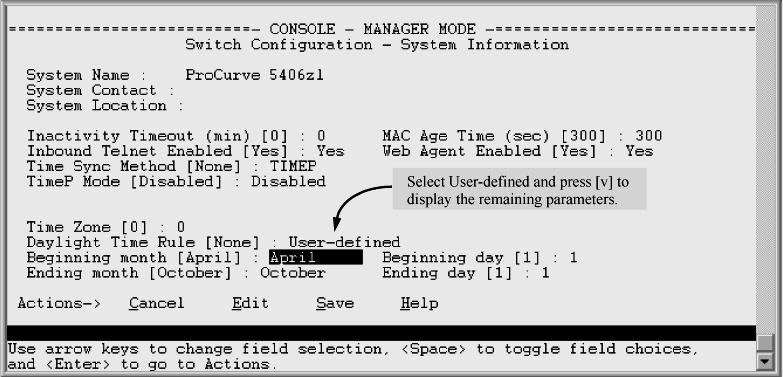Daylight Saving Time
Switches provide a way to automatically adjust the system clock for Daylight Saving Time (DST) changes. To use this feature, define the month and date to begin and to end the change from standard time. In addition to the value "none" (no time changes), there are five predefined settings named:
Alaska
Canada and Continental US
Middle Europe and Portugal
Southern Hemisphere
Western Europe
The predefined settings follow these rules:
Alaska:
Begin DST at 2 am on the second Sunday in March.
End DST at 2 am on the first Sunday in November.
Canada and Continental US:
Begin DST at 2 am on the second Sunday in March.
End DST at 2 am on the first Sunday in November.
Middle Europe and Portugal:
Begin DST at 2 am the first Sunday on or after March 25th.
End DST at 2 am the first Sunday on or after September 24th.
Southern Hemisphere:
Begin DST at 2 am the first Sunday on or after October 25th.
End DST at 2 am the first Sunday on or after March 1st.
Western Europe:
Begin DST at 2 am the first Sunday on or after March 23rd.
End DST at 2 am the first Sunday on or after October 23rd.
A sixth option named "User defined" allows you to customize the DST configuration by entering the beginning month and date plus the ending month and date for the time change. The menu interface screen looks like the following: (all month/date entries are at their default values):

Before configuring a "User defined" daylight time rule, it is important to understand how the switch treats the entries. Given the "Beginning day" and "Ending day", based on an algorithm from Sunday, the switch determines the date to change the system clock :
If the configured day is a Sunday, the time changes at 2 am on that day.
If the configured day is not a Sunday, the time changes at 2 am on the first Sunday after the configured day.
This is true for both the "Beginning day" and the "Ending day."
With that algorithm, you can use the value "1" to represent "first Sunday of the month," and a value equal to "number of days in the month minus 6" to represent "last Sunday of the month." This allows a single configuration for every year, no matter what date is the appropriate Sunday to change the clock.